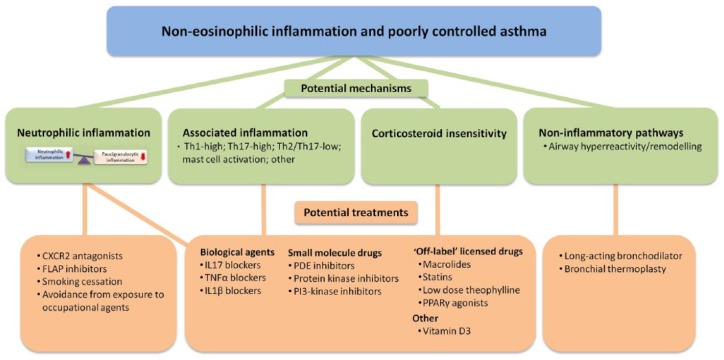Figure 2.
Targets and potential therapies for treating noneosinophilic airway inflammation in asthma.
Noneosinophilic airway inflammation is found in approximately 50% of patients with asthma. The proportion of this group with neutrophilic inflammation is less certain because of variable cut-off points used to define neutrophilia. The higher the cut-off value used to define sputum neutrophilia the greater the proportion of patients that are classified as having paucigranulocytic inflammation. Pathways that may account for poor asthma control in patients with noneosinophilic asthma including neutrophilic inflammation, associated inflammatory phenotypes (Th1-high inflammation, Th17-high inflammation, a combination of Th2 and Th17 inflammation, mast cell-induced inflammation, and other inflammatory mechanisms) as well as corticosteroid insensitivity. Noninflammatory mechanisms such as airway hyperreactivity and airway remodelling may be important in causing symptoms in some individuals. Potential treatments targeting specific pathways are listed in the diagram. Novel small molecules targeting neutrophilic inflammation, such as CXCR2 antagonists reduce neutrophils, but do not improve clinical outcomes. Smoking cessation in asthmatic smokers and removal from exposure to occupational agents reduces neutrophilic inflammation. The results of clinical trials of biological agents targeting mediators associated with noneosinophilic inflammation, such as IL-17 and TNF-α are disappointing. Preliminary studies of ‘off-label’ use of licensed drugs suggest that macrolides show efficacy in nonsmokers with noneosinophilic severe asthma and statins, low-dose theophylline and PPARγ agonists may benefit asthmatic smokers with noneosinophilic inflammation and associated corticosteroid insensitivity. Inhaled PDE4 inhibitors, dual PDE3 and PDE4 inhibitors, p38MAPK inhibitors, tyrosine kinase inhibitors and PI3kinase inhibitors are under development and these compounds may be of benefit in treating noneosinophilic inflammation and corticosteroid insensitivity. Long-acting bronchodilators or bronchial thermoplasty are possible treatment options for symptomatic patients with paucigranulocytic inflammation in whom there is no evidence of activated inflammatory pathways or corticosteroid insensitivity that could be targeted by specific therapies.
Abbreviations: CXCR, C-X-C chemokine receptor; FLAP, 5-lipoxygenase-activating protein; IL, interleukin; PDE, phosphodiesterase; PI3K, phosphoinositide 3-kinase; PPARγ,: peroxisome proliferator-activated receptor-γ.

